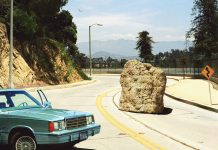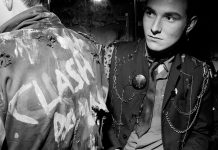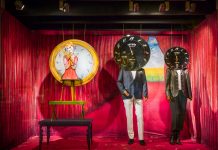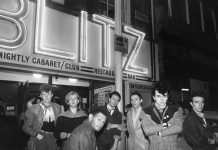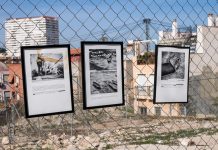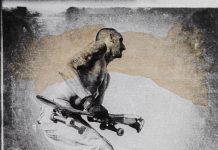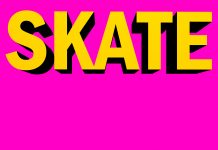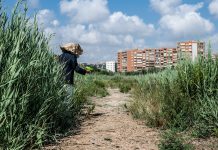
City Skate Tour #9 Alicante, 25 May 2021. Calle Capitán Boacio. Alicante. Spain. Panel de hormigón.
(1) City Skate Tour starts from a performative idea of urban space through a dissident sample of photographs, texts, photocopied, altered images, all of them belonging to the City 00Skate Days (CSKD) series. (2) To the extent that skateboarding seeks a new vital and social rhythm in the appropriation of the city and the search for alternative itineraries, the photographic exhibition can also become a differentiated urban practice, capable of creating visual thresholds far removed from uses and institutional submissions of art.
(3) The city is the nexus between image and skate. There is no claim in this. There is no other result than that which a passerby could attribute to you when encountering an unexpected image, an attribution of which any value or meaning is unknown. (4) But there are other ways of saying it: City Skate Tour proposes intervention in peripheral enclaves and restores the rhythm of a random, minimal world. That is why the influx of people in those specific spaces do not matter so much as the way in which the image becomes visible through the context that surrounds it. Skateboarding is a metaphor for that threshold.
(5) In City Skate Tour, the idea is projected into a basic action: crossing the city can be considered an imperceptible, inconsequential happening, but if at some point in the journey something causes the passer-by to stop, the action could also become a social fact. In this case, stopping is accompanied by other minimal acts: assembling the images to an urban surface has more to do with creating a site for the image than with a purely expository need.
(6) Between the action and the fact there is a whole compendium of social and artistic traditions that were going to try to show the city as something tangible associated with an altered, even revolutionary dynamic. The references are multiple, but what interested me is, above all, that the city can be used to express ideas, whether complex or simple. Ideas that become tangible in action. (7) The public expression of a work requires some type of social requirement, and this does not have to be restricted to the programmatic conventions of galleries or institutions.
(8) If the Situationists had shown another way of conceptualizing the urban experience based on a playful-constructive behavior, radicalized by their insistence on requesting for themselves a vital state that denied capitalist norms, I find in the gesture of the painter Peter Hobbs a current that unites art, nomadism and situationism. The art critic Thomas Crow would express it as an emerging art form that moved away from any foreseeable gaze: «Peter Hobbs led the situationist aesthetic towards a process of isolated nomadism», and he did so by hosting his canvases on vacant lots in the East End of London to photograph them later as an indirect, but more vivid and real, way of recreating the painting in an urban installation. War photographer Don McCullin helped him create that sensation through photographs that were to fix the fact, that moment, on the margins of institutional life.




Fotocopia #83. Perspectivas del objeto parcial contra el pavimento. 2015-2019. Texto. The skatepark revolution is a response to demand, but urban managers’ motivations for providing these parks are more complex. Through a review of their professional literature, I show that urban managers in the United States focus less on skateparks as a means of satisfying community demand and more on specific behaviors of skateboarders, such as securing majority funding for the construction of parks, refraining from bringing liability cases for injuries, and informally policing surrounding neighborhoods. The literature also notes that the parks themselves serve as zones of economic activity, where stunts are documented and distributed (in magazines and videos) by the multibillion-dollar skateboard industry. This focus in the professional literature demonstrates that urban managers view skateparks as a means by which to reward and encourage specific character traits in young people, principally personal responsibility, self-sufficiency, and entrepreneurialism. Referencia. Ocean Howell. Skatepark as neoliberal playground: urban governance, recreation space and the cultivation of personal responsibility, Space and Culture, 2008.
Fotocopia #89. Broken arm. 2016-2020. Texto. Essentially, street skaters search for skating affordances from the existing environment, whereas park skaters utilize purposely built environments that match their requirements. Affordances are the elements embedded in the environment that support and furnish an individual’s behaviors. A street skater first identifies his or her needs, then selects from available spaces and discovers the niches for skateboarding. The places that street skaters utilize range from linear space, such as sidewalks and roadsides, to specific sites, such as plazas and parks. For nonskaters, the form of the city is usually defined by architects and urban planners who transform natural landscape and shape what we know about a city. The so-called marginal spaces (spaces outside the marked and named places) are often more significant than the selected representations to skaters as they do not rely on zoning codes, architectural blueprints, or street maps to learn the urban form; they know the city by traveling through it. In fact, their use of the city often contradicts the projected functions. Referencia. Chihsin Chiu. Contestation and Conformity: Street and Park Skateboarding in New York City Public Space, Space and Culture, february 2009.




